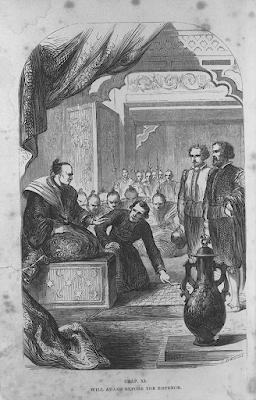Ever since opening Karen Cushmans’ Catherine Called Birdy novel back in 1996, I have remembered the freshness, energy and rebellious joy of that first page. Her determined character has been stuck in my mind:
12th Day of September. I am commanded to write an account of my days: I am bit by fleas and plagued by family. That is all there is to say.
13th Day of September. My father must suffer from ale head this day, for he has cracked me twice before dinner instead of once. I hope his angry liver bursts.
14th Day of September. Tangled my spinning again. Corpus bones, what a torture.
15th Day of September. Today the sun shone and the villagers sowed hay, gathered apples and pulled fish from the stream. I trapped inside, spent two hours embroidering a cloth for the church and three hours picking out the stitches after my mother saw it. I wish I were a villager.
And so on.
The diary begins in September 1290 but it does not focus on the intrigues of royal courts or famous historical figures, Instead, it gives us the thoughts of the writer: fourteen-year-old Catherine, nicknamed Birdy because of the number of pet birds she keeps in her chamber.
Birdy is the only daughter of Lord Rollo and Lady Aislinn, who live in a small manor house in Lincolnshire. She comments, with humour, puzzlement and rage upon her family, her friends, her everyday life and the annoying fact that her father intends to marry her to the wealthiest bidder.
Birdy does not want to be a lady, nor married. She prefers spending time with Perkin the goat-herd and her “heart’s brother”, and her other young friends in the village. She hates the needlework, restrictions and all the boring “lady-lessons” she is given by her nurse Morwenna, her mother and by various tutors.
However, her sympathetic brother Edward, a young monk in the scriptorium at the nearby abbey, has convinced their mother that Birdy should learn to read and write, even if she has to give up some of her needlework time. Reflecting on her daily life, he suggests, will help Birdy improve her character - and so the diary has begun.
Gradually, between one September and the next, Birdy’s diary shows her learning about the uses of herbs and the making of manuscripts, as well as experiencing love, jealousy and heart-break. She discovers the true story of where babies come from and drives away several suitors by tricks and bad behaviour. She sees the effects of sorrow, poverty and death and senses what her future role might be – even if early entries are laced with jokes about jakes, farts and bums, amounts of silly pranks and a quantity of curious information on odd saints. Catherine Called Birdy is an exuberant joy of a book with a character that was wonderfully “feisty” before publishers had even heard of the now overused word.
My copy of the novel had been sitting quietly on its shelf for over two decades when suddenly I heard that title again: Catherine Called Birdy has now been released as a full length film which, after a short cinema run, is streaming on Prime.
Written and directed by Lena Denham and starring Bella Ramsay as Birdy, the film a glorious medieval coming-of-age romp. Though there are moments of seriousness, the story is not solemnly told. I was reminded of “Will”, the film about young Shakespeare from the Horrible Histories team, and felt that Birdy might create a similar interest in that period of history for a young teen audience, in addition to much older persons.
Birdy, the film, starts with impact: before the opening credits, our heroine appears splattered in mud at a wild wattle-and-daub village cottage-raising, an incident shifted some way from its place in the original plot. In general, the film creates a picture of a close-knit medieval community, its seasonal festivities and the hard realities of life. This manor is a place where candles gutter, food runs scarce or goes rotten, where the privy is a public necessity, where parents expect to beat their children and Birdy’s bed is shared by her nurse Morwenna and any visiting females.
Although the film avoids the public hanging of the original book, Denham does focus on menstruation as the important indication of marriageability. Birdy’s first monthly flow is shown as a turning point in her life. Innocently fearing she might be dying, she is horrified by the kindly Morwenna’s practical explanation and determines to conceal her womanhood from her father. For a while Birdy’s ruse works but eventually, she is discovered.
After she amusingly dissuades many suitors, Lord Rollo becomes determined and accepts the offer of a man she calls Shaggy Beard, a rich much older suitor from Yorkshire, who gives Birdy a purse of silver coins, By accepting the money, she is accepting her eventual marriage, although it is agreed that Birdy can stay with her mother until the newr baby is born. In the book, Birdy gives the money to Meg from the dairy so she and her husband can swain pay the death tax and live, with Perkins in his grandmothers cottage. In the film, the money is used in another way and has a different impact.
The film reshapes and slightly restructures the book, using modern multiracial casting, a modern soundtrack as well as making the ending larger and more emotional. Birdy’s father is given a stronger role and the ending is slightly adjusted (no doubt as a reflection of the star status of the actors Andrew Scott and Billie Piper) to allow for a couple of bigger scenes, which give Birdy a true insight into the complexity of adult life and relationships.
Although I enjoyed the film very much, and loved its energy, and sense of life and laughter, certain moments felt much more "unhistorical" than others. Though not enough to overpower the pleasure or fun, I had problems with film-Birdy’s attitude to religion, to books and to writing.
In the original, Birdy has a valued book of saints, a precious item that belongs to her mother, whose family was once wealthy. Her diary entries open with a reference to the saint of that day. For example, randomly I found:
27th Day of November. Feast of Saint Fergus, an Irish bishop, who condemned irregular marriages, sorcerers and priests who wear their hair long and
17th Day of December. Feast of Saint Lazarus who was raised by Jesus and afterwards went to France.
These headings were both based on facts I found elsewhere so I am assuming that many of Cushman's references might be accurate too. They are important as indicators of the strongly religious culture and mindset of the age. In the novel, although Birdy does not reveal a great devotion to the saints or religion, she does experience it as an everyday part of her life.
Yet the film, however, pushes this attitude almost too far. When Birdy goes on an errand, in her mother’s place, to her brother Edward’s monastery, she is overcome by the sight of the young monks. She stands, eyes wide, clutching at the body of a life-size crucifix in the middle of the cloister lawn. While this image was amusing enough in its way, that scene felt total at odds with what I imagine as the spiritual frame of the age. Even knowing of the wealth of almost erotic religious literature created by certain saints, for a moment, the gap in the “history” of the film felt too large. Was it simply my response to the blatant modern mix of sacred and profane? Yet the following scene, where Birdy goes to her brother’s cell amusingly concealed beneath his cloak, did not feel seriously confrontational at all. Is there a limit to how far modern historical fiction can be stretched on screen?
This leads me to my second problem: the reverence for the act of writing and the cultural value of books. In the novel, Cushman showed Birdy absorbed in the work of the scriptorium, deciding that she would like to be a monk.
“To spend the rest of my life making pictures instead of mending and weaving would be heaven indeed!”
This book-Birdy is interested in the process, noting the monks’ desire for lapis lazuli and other long-lasting colours and inks for their manuscripts. In her enthusiasm, she tries to make her own.
“I made a paste from bilberries that looks as blue as a robin’s egg but it grows sour and so sticky that I must add a task that the brothers have never dreamed of: picking bugs out of the heavenly sky or the Virgin’s veil.”
The book-Birdy would, I felt, have had a care in the way she used her diary and did her writing, even if the results were not perfect.
However,
in the film version, Birdy’s pages are covered in careless
scrawlings, even allowing for the difficulties of a quill pen. They
look like the jottings of a modern child who believes that more
sheets of paper or another exercise book will always be available. In
my – yes, opinionated - opinion, her pages do not look like the
work of a girl who has handled vellum and observed monks working on
illuminated manuscripts or the reverence with which these
books were treated. Birdy's scrawl and sketches clashed against my
ideas of the respect for writing at that time - but am I wrong? Certainly, badly-done homework might be more meaningful to any of the young viewers than exquistite lettering and they will have time,ifthye choose, to form their own views on life in the medieval England.
Ignore my worries, because Catherine called Birdy is a treat, in either or in both its appearances. Do search them out, for yourself or your teens if you like history mixed with humour.
Even better news: Karen Cushman, the original author is still alive. I do hope she is celebrating her memorable Birdy’s bright new flight
Penny Dolan
@pennydolan1


















